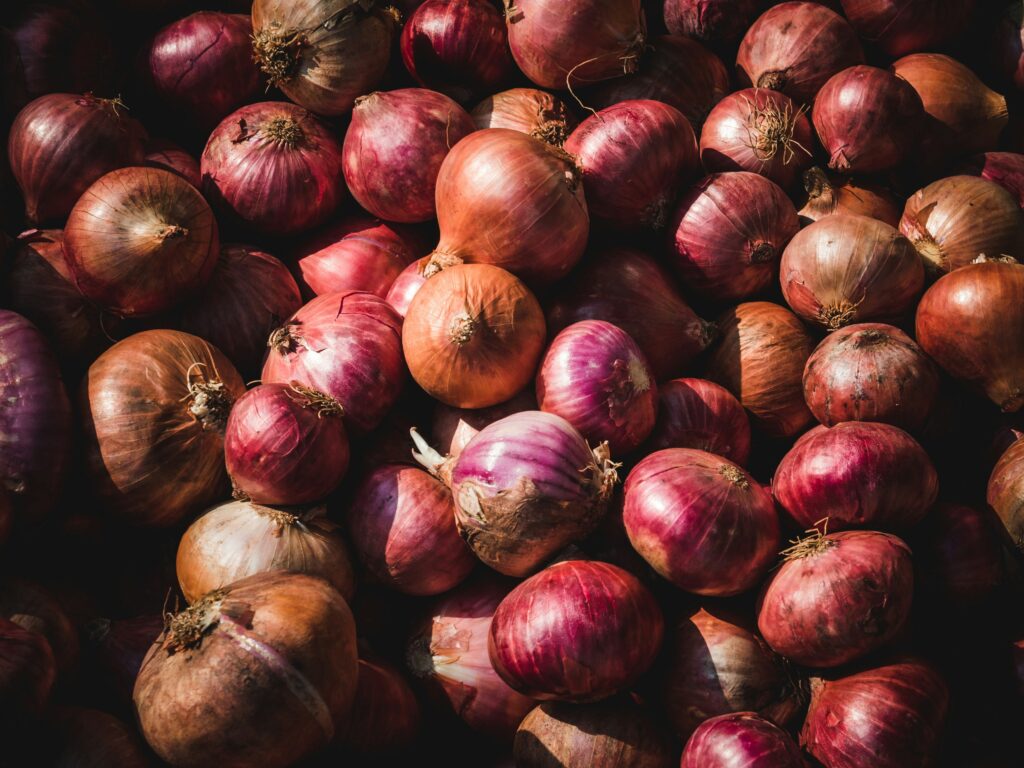Red onions are more than just a vibrant splash of color on your plate, they’re nutritional powerhouses. Loaded with antioxidants, anti-inflammatory compounds, and prebiotics that promote gut health, red onions are an easy way to elevate your meals without compromising your health goals. Whether you’re looking to reduce processed foods, cut back on sodium, or simply add more vegetables to your diet, red onions are an excellent ingredient to build around.
In this blog post, we’re exploring some delicious, healthy recipe ideas that feature red onions in creative and satisfying ways. Instead of just listing out ingredients, we’ll look at how and why these dishes work, and how red onions contribute both to flavor and nutrition.

Red Onions in Salads
One of the easiest and healthiest ways to enjoy red onions is in fresh salads. Their natural sharpness and sweetness, especially when thinly sliced and soaked briefly in cold water, make them an ideal counterpoint to creamy dressings, leafy greens, and juicy vegetables.
A favorite among Mediterranean-style dishes is a cucumber, tomato, and red onion salad tossed with olive oil, lemon juice, and fresh herbs. This trio is not only refreshing but also rich in water content, fiber, and vitamin C. Red onions add a crisp texture and a hint of heat without the need for heavy seasoning.
What’s great about using raw onion in salads is that they retain their health benefits, particularly their high content of quercetin, a flavonoid that’s been studied for its heart health, anti-inflammatory properties, and antibacterial properties. According to the National Onion Association, quercetin and sulfur compounds found in onions may help reduce inflammation and fight infections.
Plus, eating raw onion pairs beautifully with plant-based proteins like chickpeas or lentils, helping to create a satisfying and well-rounded meal. To make this salad a complete dish, consider adding grilled chicken, canned tuna, or crumbled feta cheese. Just remember that a little sliced onion goes a long way in terms of flavor, so you don’t need to go overboard.

Pickled Red Onions
If you haven’t tried quick pickled red onions, now’s the time. Unlike store-bought pickles that can be heavy on sodium and preservatives, quick pickling at home gives you total control over the ingredients. All you need is vinegar, water, a touch of sweetener (like honey or maple syrup), and your red onions.
Within 30 minutes, you’ll have a bright, crunchy, tangy topping that can be used on everything from tacos to grain bowls. Pickled red onions are especially helpful for people trying to reduce their intake of heavy sauces or salty condiments because they add a punch of flavor with virtually no fat or calories.
This is where the health benefits of onions really shine. Since the onion remains mostly raw during the pickling process, it retains more of its natural antioxidants and health properties. Vinegar, especially apple cider vinegar, offers added value by aiding digestion and stabilizing blood sugar levels, making this not only a delicious option but a smart one for anyone watching their onion nutrition and metabolic health.
Looking to shake things up? Try mixing in spring onions, green onions, or even a touch of onion powder for layered flavor. These variations still fall under the umbrella of allium vegetables, which includes garlic, white onion, and yellow onions, all known for their wide range of health benefits.
Red Onions in Broth-Based Dishes
Red onions don’t have to take a backseat when it comes to soups and stews. In fact, their slightly sweeter profile can add an unexpected dimension to brothy dishes, especially those with lentils, beans, or squash. Unlike yellow onions, which are more commonly used in cooking, red onions bring a brightness that can lift the flavor of a heavier dish.
For a healthy winter meal, try a red lentil and red onion soup with garlic, turmeric, and lemon juice. Red onions caramelize slightly in the pot and give the soup a beautiful hue and earthy richness. It’s plant-based, high in protein, and deeply comforting which is ideal for batch cooking or freezing ahead.
The health benefits of onions in this dish are plentiful. Beyond flavor, you get a mix of anti-inflammatory properties, natural prebiotics for gut health, and a decent dose of vitamin C, which supports immune function and collagen production. When paired with ingredients like turmeric and olive oil, both known for their anti-inflammatory effects, you’ve got a powerhouse dish that aligns with holistic food science principles.
Serve this soup with a slice of whole-grain toast or a spoonful of yogurt for added texture and protein. If you’re feeling adventurous, stir in a splash of onion juice or sprinkle in onion extract to enhance both the flavor and the health properties of the broth.

Final Thoughts
Whether you’re cooking with spring onions, layering flavor with green onions, or savoring the bite of a raw onion, there’s no denying the incredible health benefits of onions. From regulating blood sugar levels to supporting bone health and reducing inflammation, eating onions is a simple yet powerful way to improve your diet.
Red onions in particular deserve the spotlight. Their versatility in both raw and cooked applications makes them one of the most dynamic ingredients in the kitchen. Whether you’re roasting them, pickling them, or folding them into a salad, they add so much more than flavor; they bring color, texture, and a long list of health benefits.
So next time you plan your meals, consider how consuming onion can elevate both your dish and your health. And don’t overlook the extended onion family: from green onions to yellow onions and white onions, each variety offers something special, rooted in the timeless value of allium vegetables.